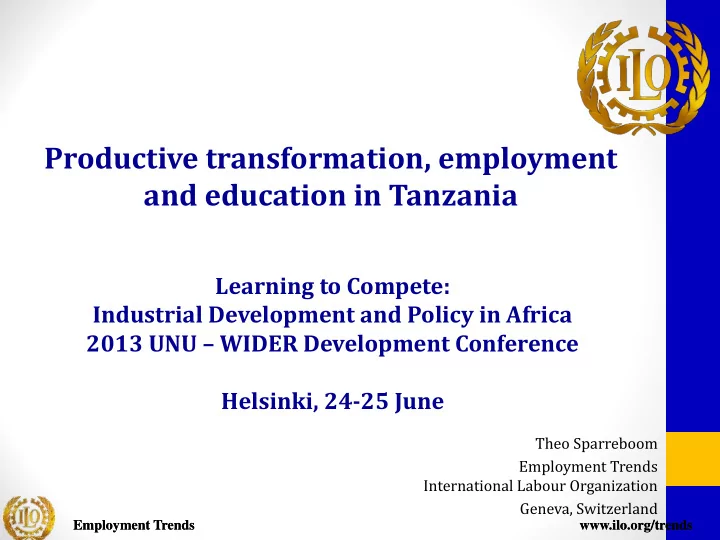

Productive transformation, employment and education in Tanzania Learning to Compete: Industrial Development and Policy in Africa 2013 UNU – WIDER Development Conference Helsinki, 24-25 June Theo Sparreboom Employment Trends International Labour Organization Geneva, Switzerland Employment Trends Employment Trends www.ilo.org/trends www.ilo.org/trends
Overview Economic and labour market context in sub-Saharan • Africa Growth and structural change in Tanzania • Structural change and education • Education intensity framework: decomposition • Structural change and job quality • Rate of return and qualifications mismatch analysis • Conclusions • Educational advance barely keeps up with structural change • Limited productive transformation translates into demand for • 2 secondary education Employment Trends www.ilo.org/trends
Labour productivity levels and average annual growth rates, by region 80 9 Output-per-worker ('000 constant 2005 international US $) Productivity level 2012 8 8.0 70 Productivity growth rate 2000-2012 7 60 6 50 Productivity growth rate (%) 5.5 5 40 4 3.9 30 3.4 3 20 2.3 2.3 2.2 2 1.6 10 1 0.9 0.9 0 0 Sub-Saharan Africa South Asia South East Asia and the Pacific East Asia North Africa World Latin America & the Caribbean Central and South Eastern Europe Middle East Developed Economies and European (non-EU) and CIS Union 3 Source: Global Employment Trends 2013: Recovering from a second jobs dip (Geneva, ILO, January 2013) Employment Trends www.ilo.org/trends
Vulnerable employment in sub-Saharan Africa 300 85 Vulnerable employment Vulnerable employment rate 250 Vulnerable employment rate (percentage) 83 Vulnerable employment (millions) 200 81 150 79 100 77 50 4 0 75 2000 2001 2002 2003 2004 2005 2006 2007 2008 2009 2010 2011 2012 Source: Global Employment Trends 2013: Recovering from a second jobs dip (Geneva, ILO, January 2013) Employment Trends www.ilo.org/trends
Economic growth and structural change in Tanzania • Economic growth averaged 7.2 per cent annually from 2001 to 2006 • Productivity growth averaged 3.3 per cent in this period • Vulnerable employment rate decreased by only 2.6 percentage points Average annual growth of value added, employment and productivity by broad economic sector, 2001-06 (%) Value added Employment Productivity 20 15 10 5 0 Agriculture Industry Services National -5 5 -10 Employment Trends www.ilo.org/trends
Employment and education in 2001 and 2006 2001 2006 100 Distribution of 80 employment by broad 60 sector (%) 40 20 0 Agriculture Industry Services Unemployed 2001 2006 20 15 Education intensity by broad sector (share of workers with 10 at least lower secondary education, %) 5 6 0 Agriculture Industry Services Unemployed Employment Trends www.ilo.org/trends
Decomposition of structural change and education intensity Between Within Share of GDP per sector sector Education agriculture in capita change in change in intensity the labour Period (constant education education (end of force 2000 US$; end intensity intensity period, %) (end of of period) (%) (%) period, %) Tanzania 2001-2006 88.3 11.7 5.9 70.0 392 India 1993-2004 37.3 62.7 21.5 51.3 525 Indonesia 1994-2004 9.6 90.4 45.9 40.5 876 Philippines 1991-2004 29.0 71.0 50.9 33.1 1,153 Thailand 1995-2005 17.0 83.0 36.5 42.0 2,360 Note: education intensity is defined as the proportion of workers with at least secondary education 7 Sources: ADB (2007); Sparreboom and Nübler (2013); World Bank (2012b). Employment Trends www.ilo.org/trends
Structural change, job quality and education • Advance in education hardly sufficient to keep up with the pace of structural change • But large differences in dynamics within sectors between vulnerable and non-vulnerable employment segments • In contrast to the change in education intensity across all workers, education intensity decreased in non-vulnerable employment at the national level • Productive transformation within sectors was mostly limited to vulnerable employment, i.e. the low productivity segment of employment Education intensity by broad sector (%) Vulnerable employment Non-vulnerable employment 2001 2006 2001 2006 35 9 8 30 7 25 6 20 5 4 15 3 10 2 5 1 8 0 0 Agriculture Manufacturing Services Aggregate Agriculture Industry Services Aggregate Employment Trends www.ilo.org/trends
Demand for education: wage returns Rates of return for education are high in Tanzania, but • slightly declined between 2001 and 2006 Returns to years of schooling increased strongly in • mining and construction Rates of return to secondary education rose sharply • Decreasing returns for tertiary education reflect: • Lack of productive transformation within sectors • Quality of some tertiary qualifications • Rates of return to levels of education (%) 2001 2006 25 20 15 10 5 9 0 Primary Secondary Tertiary Employment Trends www.ilo.org/trends
Skills mismatch: underqualification • Skills and qualifications mismatch can be measured based on the correspondence between the occupational distribution and levels of educational attainment • Underqualification is widespread in Tanzania, and is decreasing only slowly • Mismatch analysis confirms the need for secondary education across all jobs Underqualification (%) 2001/02 2004 2006 2008 2010 Europe 36.4 34.5 32.0 31.5 28.6 Philippines 35.9 29.4 Tanzania 93.5 90.7 10 Sources: ILO (2013b); Sparreboom and Nübler (2013); El Achkar Hilal et al. (2013). Employment Trends www.ilo.org/trends
Conclusions Educational advance barely keeps up with structural change • Large differences within economic sectors mask the dynamics of • productive transformation: structural change in non-vulnerable employment is far more limited Limited productive transformation translates into demand for • secondary education Industrial development policies need to support productive • transformation patterns that create more decent jobs; these policies need to be aligned with education and training policies 11 Employment Trends www.ilo.org/trends
Thank you for your attention Employment Trends www.ilo.org/trends
Recommend
More recommend